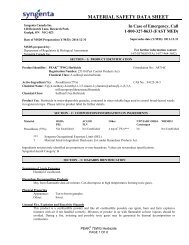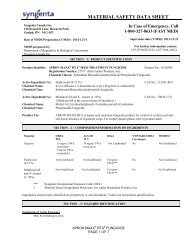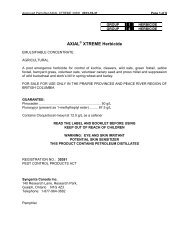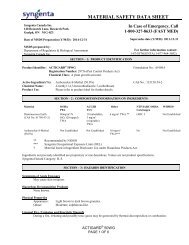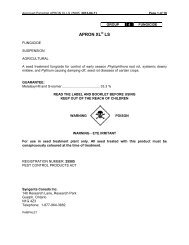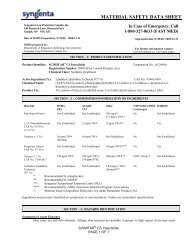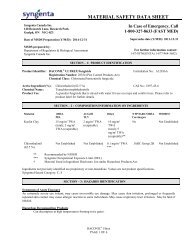Daconil 2787 MSDS - MGS Horticultural Inc.
Daconil 2787 MSDS - MGS Horticultural Inc.
Daconil 2787 MSDS - MGS Horticultural Inc.
- No tags were found...
You also want an ePaper? Increase the reach of your titles
YUMPU automatically turns print PDFs into web optimized ePapers that Google loves.
organ toxicity. Subsequently, IARC identifies chlorothalonil as a 2B carcinogen (possiblycarcinogenic to humans).Other Toxicity Information:Surveillance of chlorothalonil plant workers for over twenty years has not demonstrated any increase in oncogenicpotential to humans. May cause irritation to the respiratory tractToxicity of Other ComponentsTest results reported in Section 11 for the finished product take into account any acute hazards related to theexcipient ingredients in the formulation.Amorphous SilicaAmorphous Silica is listed as an IARC (Group 3) carcinogen not classifiable as a human carcinogen (NoData Available) with limited animal evidence. Prolonged exposure to amorphous silica may causedamage to respiratory system and irritation to skin and eyes.Propylene GlycolReported to cause central nervous system depression (anesthesia, dizziness, confusion), headache andnausea. Also, eye irritation may occur with lacrimation but no residual discomfort or injury. Prolongedcontact to skin may cause mild to moderate irritation and possible allergic reactions. Chronic dietaryexposure caused kidney and liver injury in experimental animals.Other materials that show synergistic toxic effects together with the product: None known.Target OrgansActive IngredientChlorothalonil:Inert IngredientsAmorphous SilicaPropylene GlycolLung, eye, kidney.Respiratory tract, skin, eye.CNS, skin, eye, kidney, liver.SECTION – 12: ECOLOGICAL INFORMATIONSummary of EffectsThis product is a fungicide that is mixed with water and applied as a spray for control of plant diseases . The activeingredient, chlorothalonil, is practically nontoxic to plants, algae, birds and insects but is slightly toxic tomammals, and highly toxic to fish and aquatic invertebrates .Eco-Acute ToxicityChlorothalonil:Green Algae 5-day EC 50Invertebrates (D. magna) LC 50 /EC 50Fish (Rainbow Trout) 96-hour LC 50Bird (Mallard Duck) Oral LD 50190 ppb70 ppb47 ppb> 4640 mg/kgEnvironmental FateChlorothalonil has a low bioaccumulation potential, low mobility in soil and is not persistent in soil or water. Thedissipation half-life in soil is 10-60 days and in water it is



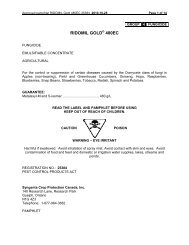
![gesagard 480sc [pamphlet] - Syngenta Crop Protection](https://img.yumpu.com/50945984/1/190x245/gesagard-480sc-pamphlet-syngenta-crop-protection.jpg?quality=85)
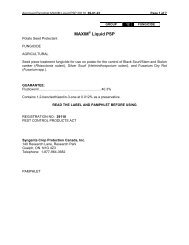
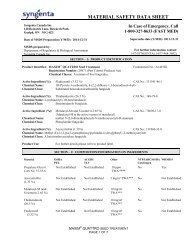
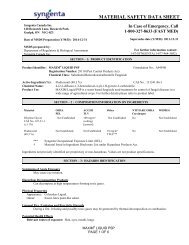
![ridomil Gold mz 68wp [bag] - Syngenta Farm](https://img.yumpu.com/49025229/1/190x245/ridomil-gold-mz-68wp-bag-syngenta-farm.jpg?quality=85)
